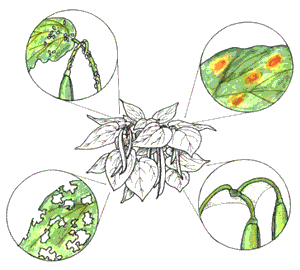 |
How To Use This Problems Section
The chart is organized to give you a quick and dirty summary of the possible symptoms that you may encounter. Those problem causes for which we have full files will be linked to those files. Those causes with no link will have a paragraph below the chart helping you deal with that particular problem.
| Problems of Snap Beans | |
|---|---|
| Symptom | Probable Cause |
| Seeds Sprout But Fail To Leaf Out | Physical Injury |
| Seedlings Leggy And Weak | Too Much Shade |
| Leaves Look Scorched Or Bronzed | Ozone Pollution |
| Foliage Curls, Puckers, And Turns Yellow | Aphids |
| Tiny Holes In Leaves | Flea Beetles |
| Leaves Are Skeletonized | Japanese Beetles |
| Leaves Are Skeletonized | Mexican Bean Beetles |
| Leaves Show Pale Spotting | Spider Mites |
| Large Ragged Holes In Leaves | Slugs |
| Plants Are Frail, With Yellow Leaves | Whiteflies |
| Water-soaked Spots On Pods, Stems | Anthracnose – A fungal disease |
| Plants Wilt Rapidly | Bacterial Wilt |
| Orange-tinged Spots Under Leaves | Rust – a fungal disease |
| Curled, Twisted Leaves | Curly Top |
| Yellow, Bushy Plants | Bean Common Mosaic Virus |
| Dusty Gray Coating On Foliage | Powdery Mildew A fungal disease |
Seeds Sprout But Fail to Leaf Out Due To Physical Injury
ccasionally young snap bean seedlings will fail to develop leaves after they have emerged from the ground, a condition known as “baldheading.” This may be caused by some sort of injury to the seeds during harvest, packaging, storage, or handling. Pull out the deformed plants and plant new seed.
Seedlings Leggy And Weak From Too Much Shade
If snap bean plants do not enjoy at least 8 hours of sun a day, they lack vigor. They stretch to reach light if they are in shade during a part of the day and they become frail and leggy. If possible, remove or cut back any tree branches or other plants that are shading the beans. Choose a more open, sunny spot to plant.
Leaves Look Scorched Or Bronzed From Ozone Pollution
Bean plants are sensitive to ozone produced by industry and car emissions. Tissues of affected plants appear bronzed or slightly scorched and leaves develop spots that penetrate through the entire leaf. This type of environmental injury can kill a young plant in a matter of days. Tolerant snap bean varieties include ‘Astro,’ ‘Blue Crop,’ ‘Pencil Pod Wax,’ ‘Tendergreen,’ ‘Sungold,’ and ‘Tendercrop.’ (‘Homey Gold’ and ‘Dwarf Horticultural’ are particularly sensitive to ozone injury.)
Plant Wilts Rapidly From Bacterial Wilt
Bean plants infected with this disease wilt suddenly and die without showing any signs of yellowing or spotting of the foliage. Bacterial wilt cannot be cured, so remove the plants promptly and discard them in the trash. Do not compost them. Wash your hands and any tools in a bleach solution (1 part household bleach to 4 parts water) before touching other plants. Prevent bacterial wilt by removing diseased plant parts, using fresh mulch and planting resistant bean varieties such as ‘Tendergreen.’
Leaves Curled And Twisted Because Of Curly Top
Seedlings infected with curly top disease show yellow, curled and puckered foliage. The disease dwarfs and kills them. Infected older plants do not show obvious symptoms. Curly top cannot be cured. Remove and destroy infected and surrounding plants. Do not compost them. Prevent curly top by growing resistant varieties such as ‘Cape’ and ‘Great Northern.’ Also, control whiteflies and leafhoppers which can transmit the disease.
Yellow, Bushy Plants Due to Bean Common Mosaic Virus
Bean common mosaic virus causes stunted, yellow, bushy plants and foliage that has a “shoestring” appearance due to loss of leaf surface from the midveins. Individual leaflets curl along their midvein, and bean pods are distorted. Mosaic cannot be cured. Remove and destroy the infected and surrounding plants. Do not compost them. Control aphids which spread mosaic as suggested above. Plant resistant varieties such as ‘Blue Lake’ (pole), ‘Contender,’ ‘Derby,’ ‘Golden Wax Improved,’ ‘Great Northern,’ ‘Greensleeves,’ ‘Kentucky Blue,’ ‘Tendercrop,’ or ‘Topcrop.’ Most bush bean varieties are resistant to mosaic disease.

